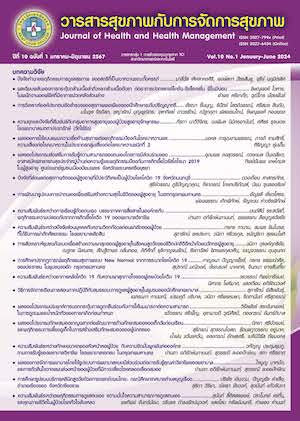The Effects of Participatory Nursing Model on Nurses’ Perception for Professional Value and Decision for Advance Care Planning of Patient with Risk of Stroke
Keywords:
Participatory Nursing Model, Perception for Professional Value, Decision for Advance Care, Risk of StrokeAbstract
This semi-experimental research The objective is to study the results of using participatory nursing models to recognize the professional value of professional nurses. And the advance planning decision of patients with stroke risk The sample is divided into 2 groups, namely the professional nursing group that operatesIn the 25 gymnast patients and the user group, the control group is a group in which 20 users receive traditional nursing and the trial group is a group in which users are nursing using participatory nursing forms 20 Research tools have 2 parts. Part 1 is an experimental tool. And the tools used to direct the experiment are as follows: 1.1 participatory nursing model By using the concept of participatory management principles of Susshkin And operated byParticipation of professional nurses, internal medicine ward, 1.2 tools used to supervise experiments, including 1) knowledge tests About stroke and advance planning decisions of professional nurses Before and after the development of participatory nursing models and 2) Knowledge test In practice when having a stroke Of service users After the development of a participatory nursing model, Part 2, the tools used to gather information are as follows: 2.1 Yon Eunja’s Nursing Professional Recognition Questionnaire and Faculty (Yeun et al., 2005) And 2.2 knowledge evaluation model And pre-planned decisions developed by the researcher And the patient’s advance decision record in writing The statistics used in the research are the average percentage, standard deviation, and comparison of knowledge and judgment.The pre-planned mind of the user group during the period after receiving the same nursing and after using the participatory nursing model by Mann-Whitney U statistics. The results show that 1. After using the participatory nursing model Nurses have a higher professional value recognition of professional nurses than before using the participatory nursing model. When considered on a side basis, found that After using the participatory nursing model Nurses that are sample groups have a high level of professional value recognition.More than before, the use of 3-sided participatory nursing models is 1) Professional appreciation 2) Social and cultural awareness 3) Role in nursing services As for the perceived professional value that is not higher, there are 2 areas 1) Nursing professionalism and 2) Nursing initiatives and 2. Knowledge and advance planning decisions of service users receiving participatory nursing forms Higher than those receiving traditional nursing. Statistically significant at level .05.
References
กรมสนับสนุนบริการสาธารณสุข. (2564). คู่มือมาตรฐานระบบบริการสุขภาพ ปี 2563 (ฉบับส่งเสริมและพัฒนาสถานพยาบาล). สืบค้นจาก https://stopcorruption.moph.go.th/application/editors/userfiles/files/คู่มือมาตรฐานระบบบริการสุขภาพ%20ปี%202563%20(ฉบับส่งเสริมและพัฒนาสถานพยาบาล).pdf
กนกพร จิวประสาท. (2558). บทบาทพยาบาลและการสนับสนุนการตัดสินใจเลือกรักษาในระยะสุดท้ายในผู้ป่วยวิกฤต : กรณีศึกษา. วารสารพยาบาลโรคหัวใจและทรวงอก, 26-27(2), 1-2.
กนกอร ธารา, สุวิณี วิวัฒน์วานิช และจิราพร เกศพิชญ วัฒนา. (2552). คุณค่าในงานพยาบาล: ความหมายและประสบการณ์ของพยาบาลวิชาชีพ. วารสารวิทยาลัยพยาบาลบรมราชชนนี กรุงเทพ, 25(2), 1-1.
คลินิกโรคจากการทำงาน กลุ่มงานอาชีวเวชกรรม โรงพยาบาลชัยนาทนเรนทร. (2560). โรงพยาบาลชัยนาทนเรนทร. สืบค้นจาก http://chainathospital.moph.go.th/chainatweb/file_store_path/20181218154956-34-10451.pdf
จารุณี ดาวังปา และมณีรัตน์ ภาคธูป. (2560). คุณภาพบริการตามความคาดหวังและการรับรู้ของผู้ป่วยประกันสังคม โรงพยาบาลเอกชนแห่งหนึ่งในเขตกรุงเทพมหานคร. วารสารวิชาการมหาวิทยาลัยอีสเทิร์น, 11(2), 215-226.
ทรรศนันทน์ ไทยอัฐวิถี, และอภิญญา จำปากูล. (2562). ปัจจัยที่มีอิทธิพลต่อการดูแลที่เน้นผู้ป่วยเป็นศูนย์กลางตามการรับรู้ของพยาบาลวิชาชีพที่ปฏิบัติงานในโรงพยาบาลศรีนครินทร์ มหาวิทยาลัยขอนแก่น. ศรีนครินทร์เวชสาร, 34(2), 198-204.
เบญจมาศ ปรีชาคุณ, วรศรา ตุวยานนท์, เพชรรัตน์ เนตรมุ่ย, และปาริชาติ ดำรงรักษ. (2558). การรับรู้ของพยาบาลวิชาชีพเกี่ยวกับภาพลักษณ์ที่ส่งผลต่อคุณค่าและความศรัทธา ในวิชาชีพการพยาบาล. พยาบาลสาร, 41(1), 122-131.
ปฐมวดี สิงห์ดง และชนกพร จิตปัญญา. (2555). ประสบการณ์ของสมาชิกครอบครัวในหอผู้ป่วยวิกฤต : การวิจัยเชิงคุณภาพ. รามาธิบดีพยาบาลสาร, 18(3), 404-417.
สุริยา ฟองเกิด, ศุภรา หิมามันโต, และสืบตระกูล ตันตลานุกูล. (2559). การพยาบาลที่เน้นครอบครัวเป็นศูนย์กลาง: จากทฤษฎีสู่การปฏิบัติในการดูแลผู้ป่วยวิกฤตระยะสุดท้ายในหอผู้ป่วยหนัก ตามบริบทของสังคมไทย. วารสารวิทยาลัยพยาบาลพระปกเกล้า จันทบุรี, 27(ฉบับเพิ่มเติม), 170-178.
Sashkin, M. (1982). A Manager’s Guide to Participative Management. New York: American Management Associations.
Downloads
Published
How to Cite
Issue
Section
License
Copyright (c) 2024 Journal of health and health management

This work is licensed under a Creative Commons Attribution-NonCommercial-NoDerivatives 4.0 International License.




